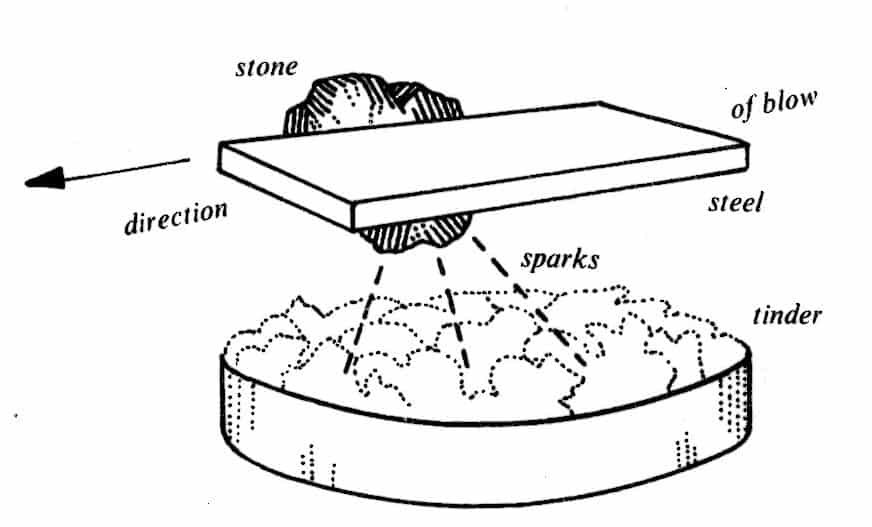This is a gem from yesteryear. So much useful survival knowledge is all-but lost: ‘Fire Without Matches: More nonsense has been said and written on the subject of lighting fires without matches than on any other—except, of course, the birth of the kangaroo. How can one tell, by reading what a man has written about it, that he couldn’t make it work if challenged to give a demonstration? Quite easily, and it can be summed up in six words.- ‘The age of miracles is past”.
It would be nothing short of a miracle if a fire could be lit by some of the methods described. This is an example: ‘Sparks struck off the flint by the steel are caught on dry grass or cotton threads and are then blown into flame’. It is incorrect in two ways. The spark comes from the steel, not the flint. It is a speck of metal, heated to incandescence by some of the energy expended in the blow of the steel against a stone even harder than itself.
Further, no matter how many of these sparks are rained on to dry grass, cotton, bark, and similar stuff, they will never ignite it. Apart from gunpowder, never used nowadays in the Army, and highly inflammable vapours such as those from petrol and alcohol, those sparks will ignite nothing except tinder.
When bushcraft training began in the Army, we were faced with the problem of making tinder from a substance which a serviceman would have with him, or could find in the bush. This ruled out the use of chemicals such as saltpetre or chlorate of potash. A round was made of technical schools and the university; old text-books from public library vaults were consulted without success. Tinder-making without chemicals seemed to be a lost art. Then a senior officer, who held an arts and not a science degree, hit upon a simple solution.
‘No use going to orthodox schools and universities,’ he said, smiling. ‘Try a different kind of educational establishment— the jail.’
‘We’ve got the man you want locked up now,” said the jail superintendent. ‘No matter how thoroughly we search him, he can always light a smoke in his cell. Mandrake’s got nothing on him. I’ll get him for you.’
Old Bob was suspicious at first but when told why the information was required he took me out of sight and hearing of the warders and parted with all his secrets. He did more than talk about it; he demonstrated everything as he went along. That old man had been in custody for most of his life, but he did more for the troops than many of those who have never seen the inside of a jail. Thousands of soldiers had reason to bless him when the matches gave out.
If flint is unobtainable, any hard rock will do; quartz, chert, chalcedony, etc. For the striker, carbon steel must be used, such as the back of a knife, a safety razor blade, or a piece of a file. Alloy steels such as a hacksaw blade will not do, neither will soft iron. The only substitute which occurs naturally is iron pyrites, the hard and brassy ore sometimes mistaken for gold by amateur prospectors. Best results in this case are achieved by striking one piece of pyrites against another, but even so the sparks are dull red instead of at white heat and it is often necessary to do a great deal of hammering before the tinder catches.
An airtight, waterproof container is necessary for the tinder. The ordinary boot polish tin is the easiest to obtain, but if cut off from all the resources of civilisation a substitute must be found. Prehistoric man in Europe used a hollow bone fitted with a wooden plug. A member of the A.I.F., cut off by the Japanese advance, used a short length of bamboo fitted with a stopper.
The best tinder is made from a piece of cotton cloth, washed to remove dirt, sweat, and grease, then dried thoroughly. First scour the tin with sand, dry earth, or ashes to remove any traces of polish. Place it on the ground with the lid beside it. Light a small fire, take a piece of the cotton cloth about the size of a handkerchief, place it across a couple of sticks and hold it over the fire, out of contact with the flames. This makes sure that it is dry.
As soon as it starts to scorch, let it take fire. It will flare up. As the last of the flame is dying out, lower it into the tin, pack it down with two sticks and at once put on the lid. When it has cooled, remove the lid and the tinder is revealed as black, fragile flakes. If cotton cloth is not available, substitutes can be found in wild cotton, taken from the ripe pods, thistledown, the silky threads from the fruits of the kapok tree, or the brown fluff from the base of the leaves of the palm-like Macrozamia, but this last-named substance must be first boiled to remove the gum and then dried.
Tease any of these substances into a large ball, light it, and at once pack into the tin and put the lid on, as they burn very rapidly. Another substitute is the large, white, bread-like fungus (punk) found growing on trees, or the pith found inside some species of reeds. Break both into little chips, then heat on a piece of tin held over a fire or on a hot stone. As soon as they are glowing, rake into the tinderbox and put on the lid.
All these forms of tinder ignite at the touch of a spark because the cellulose in them has been reduced to a mass of carbon filaments, through excluding the air at the critical point in the initial combustion.
To light a fire with tinderbox, flint, and steel, have ready what the bushman calls ‘bull’s wool’—dry grass or bark rubbed to fluff, coconut fibre, or anything else of the kind, as well as a heap of kindling sticks. Place the tinder-box on the ground with the lid off, hold the piece of stone between the thumb and finger of the left hand and about 8 centimetres above the tinder. Take the steel between the thumb and forefinger of the right hand and strike a light, quick blow with the edge of the steel across a sharp angle of the stone. Move the steel parallel to the ground; do not strike downward, as this is likely to hit the tin and scatter the contents, with unfortunate results if the ground is wet and the tinder becomes damp.

Flint and steel outfit
A shower of sparks will fly off if the blow is struck in the right way and the tinder will glow where any touch it. Pick out a burning piece of tinder and put the lid on the tin at once, for otherwise the rest of the tinder will burn to ash within half a minute. Put the burning tinder in the middle of a small bunch of bull’s wool, blow on it gently until it takes fire, and poke it under the heap of sticks.
In passing: I first introduced these boot polish tin, piece of quartz, and safety razor blade outfits in Western Australia in 1942. A few months later, in Queensland, I found them in general use, as soldiers had sent samples and instructions home to their families. They definitely helped to overcome the wartime shortage of matches for civilian use. It furnishes a modern example of the spread of knowledge known as culture diffusion to anthropologists’.
From, ‘The Bushman’s Handbook’ by H.A. Lindsay. Harold Lindsay was a survival instructor with the Australian and American troops during World war 2.
PS: I always carry something to help start a fire: a couple of esbits and a scrap of bicycle inner tube and of course I use a metho stove so I always have a bit of that too. You should read the post How to Light a Fire in the Wet.
PPS These lightweight aluminium cans would be excellent for your tinder.

Used the oxygen deprived Cotton tinder for yonks.
Also various Large commensal fungi found in Bush can make good ” punk ” .
However easy first my motto.
I carry small screw top vitamin container stuffed with Cotton balls and soaked in kero. First spark ? Even a weak one.
Fire every time.
Yes, there are easier/other ways to make a fire. I always carry some bicycle inner tube myself. It lights even when wet and is hard to put out. Cheers, Steve.